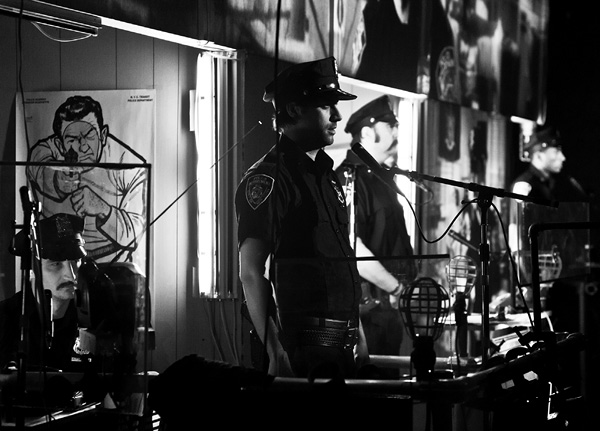
NEWYORKLAND
first performed on
November 9, 2011
Theatre Junction Grand, Calgary, Canada / On the Boards, Seattle, WA
performed eight times in 2011
TEMPORARY DISTORTION
Kenneth Collins, William Cusick, John Sullivan, TaraFawn Marek
New York, NY
851470410k851470410e851470410n851470410n851470410e851470410t851470410h851470410@851470410t851470410e851470410m851470410p851470410o851470410r851470410a851470410r851470410y851470410d851470410i851470410s851470410t851470410o851470410r851470410t851470410i851470410o851470410n851470410.851470410c851470410o851470410m
temporarydistortion.com
NEWYORKLAND
TEMPORARY DISTORTION
“Newyorkland” is not a play. It is an assemblage that attempts to address the subject of police work by combining documentaries, police procedurals, firsthand officer accounts, personal interviews, and pure fiction. Assemblage is the artistic process of putting found material together in such a way that forms a new unique artwork. Each non-art object in the assemblage acquires aesthetic meaning only within the context of the whole. To think of the work as assemblage is a purposeful attempt not to think of it as theater.
Temporary Distortion’s practice is to approach performance as a form of sculpture placed on a stage. In each piece, an immersive box-like structure appears as a framing device for the human body. This frame emphasizes the material presence of the body in space by circumscribing its form. The additional stillness of the performer allows the body to be regarded in a way similar to how we view sculpture in a gallery. A lack of action provides the necessary time for the viewer to actively contemplate the body of the performer. In addition to the sculptural form of the work, a constant stream of video projection covers the entire installation and provides a parallel visual language to the sculptural language found on stage. A juxtaposition of lush dreamlike imagery provides the necessary counterpoint to physical grid-like formalism. With multiple performers playing similar characters in the film, contradictions in narrative and fractures in identity are formed. By introducing a certain level of confusion, we allow the viewer to become an active participant in the construction of meaning. This continual juxtaposition of stage and cinema is one of complement, complication, and contradiction. It suggests multiple ways to interpret relationships between characters and to disentangle perpetually shifting narrative fragments. While numerous performers often inhabit a sculpture together, they never make eye contact, never touch, and barely move. In this way, each performer in the assemblage performs a type of solo. This allows for relationships to be built not between character and character but between the performer and all of the other formal elements of the production. By working in this way, we short-circuit conventional expectations. The viewer’s focus is placed in a continual state of flux between the elements of the performance so that relationships between audience and scenography, between text and video, between sound and space are all equally important to informing any given moment.